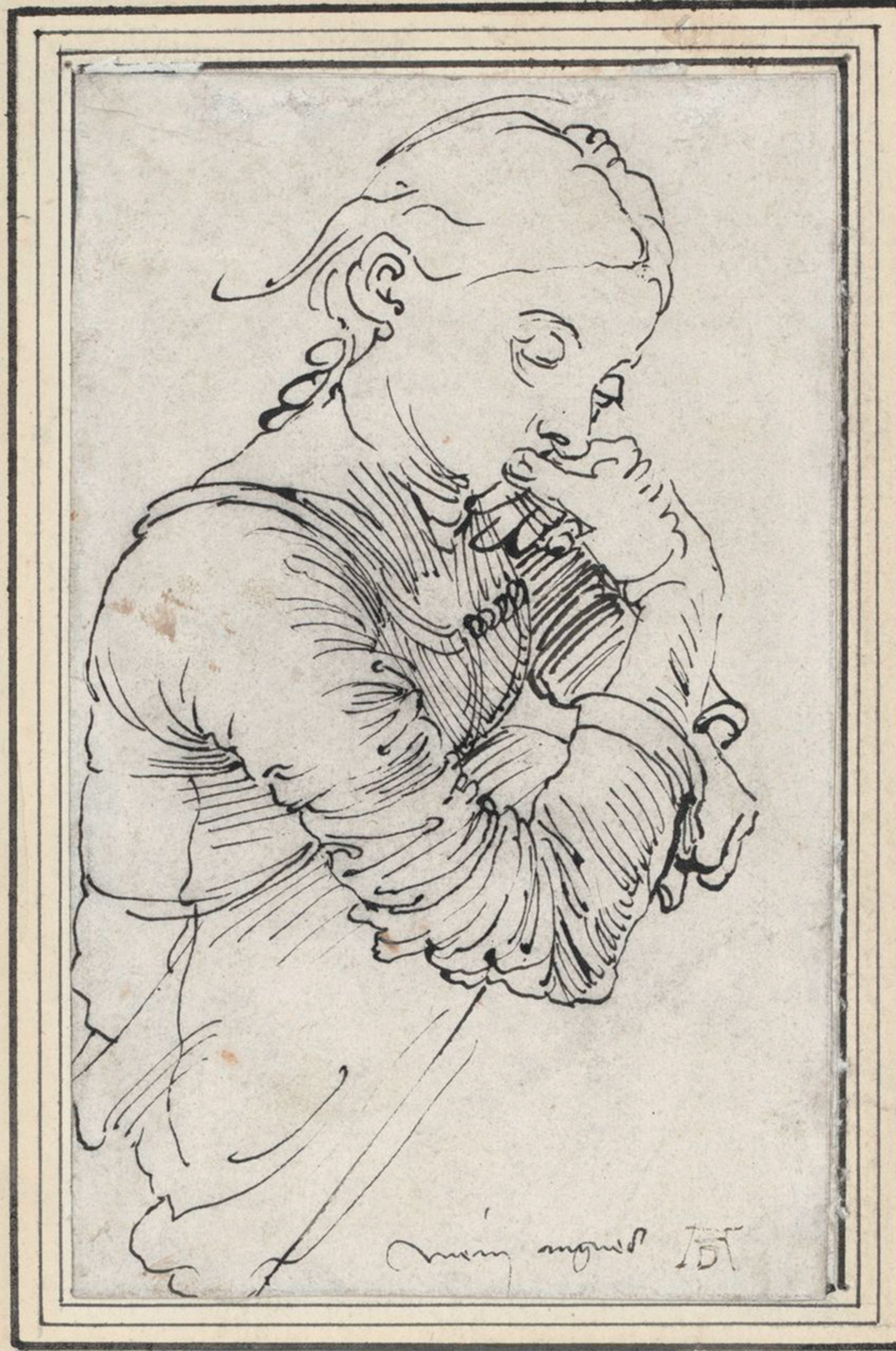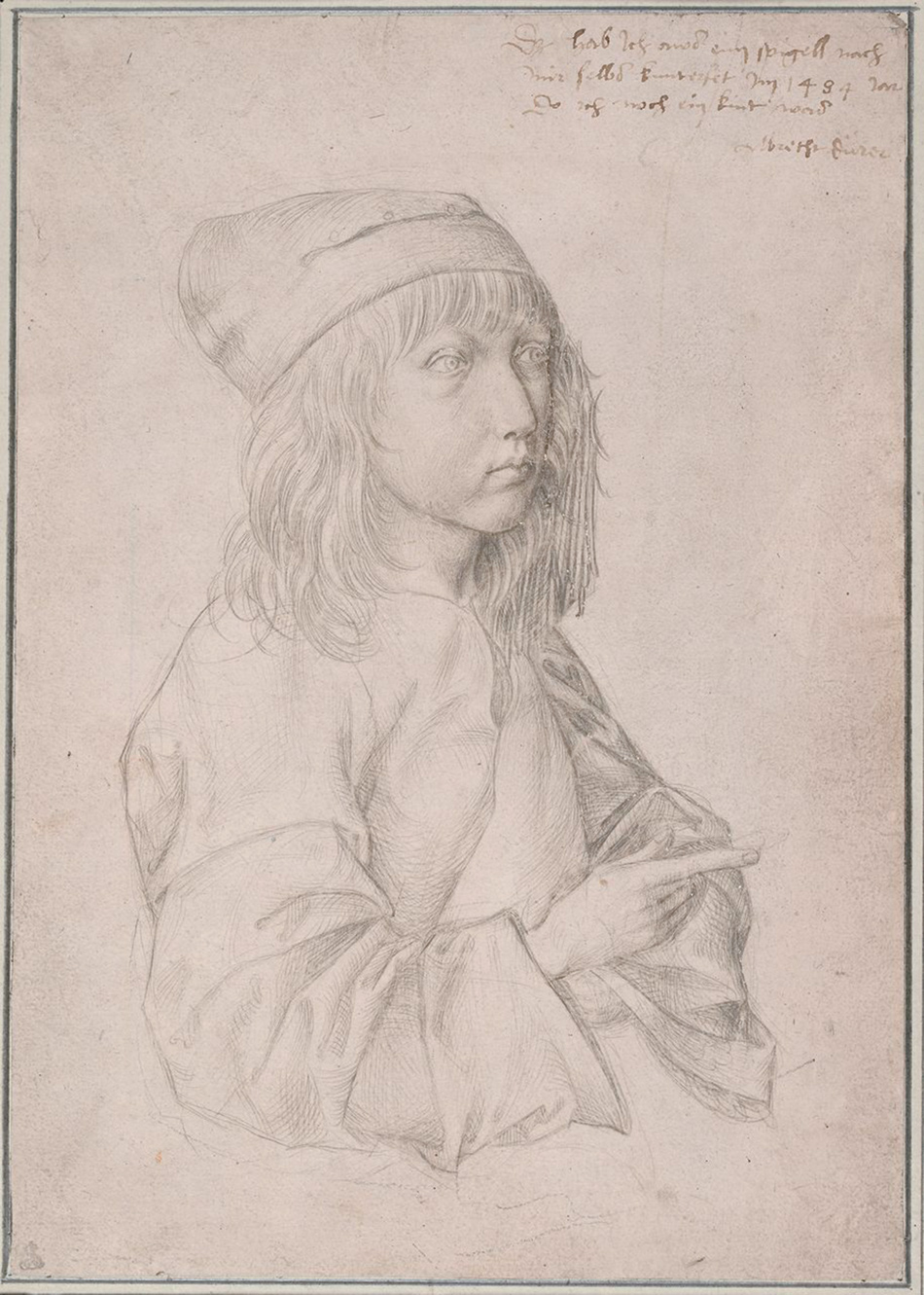In the summer of 1494, soon after his engagement, Albrecht Dürer made a startlingly intimate drawing of his fiancée, Agnes Frey. One might have expected a twenty-three-year-old to depict his betrothed as a source of love, or comfort, or well-being, all the more since her substantial dowry would soon launch his independent career. Instead, Albrecht showed Agnes twisted up in a knot of anxious introversion. She looks withdrawn and preoccupied, and the circles under her heavy-lidded eyes may even make one think she has been crying.
In its frank portrayal of an informal moment of unguarded emotion, there had never been a drawing quite like this before. Typically portraiture was honorific and meant to represent the exemplary virtues of the person shown; Dürer instead often sought to capture the idiosyncratic and psychological characteristics of the people he portrayed. He was fascinated with the close scrutiny of dark and brooding emotion. This is especially evident in his self-portraits, many of which show him in states of melancholy, doubt, or disease. Consider the self-portrait that he drew at the age of thirteen. It is made in ravishingly fine silverpoint, yet his large, staring eyes have a curiously anxious and unsettled look. The precocity evident in this sheet is not only in the flawless technique, but also in the impulse to self-examination.
This portrait is the opening work in the extraordinary exhibition about Albrecht Dürer that is on view at the National Gallery of Art through June 9. The show is composed almost entirely of works on loan—more than ninety drawings and watercolors and some twenty prints—from the Albertina Museum in Vienna, whose collection of art by Dürer is the finest in the world. These works are superb in quality and condition and most have an unbroken chain of provenance going directly back to the artist himself. They have been supplemented by additional items from the National Gallery’s own excellent collection of works by the artist. The result is the most comprehensive and revelatory show about Dürer to be held in America in over forty years.
Seeing this large group of prints, watercolors, and drawings gives you a more direct and intimate view of Dürer than you can ever have looking at the works in reproduction, or reading a book about him. A great many of the items on exhibit in Washington, not just the portraits, seem to be wrapped up in the artist’s personal concerns. Dürer was perhaps one of the first artists in history to work primarily at his own direction, rather than on commission and at the pleasure of princes and other exigent patrons. The change was made possible by his concentration on printmaking rather than painting as his main artistic and commercial endeavor. Most paintings of this time, such as altarpieces, were made for well-established religious or civic purposes, and the patrons and other viewers had specific needs and strong expectations regarding both what was depicted and how it was represented. But printmaking was a completely new medium, little beholden to tradition. Even when treating biblical themes, Dürer was comparatively free to pursue a more personal investigation of subject matter.
In Dürer this lyrical tendency was predominately religious in expression. To be sure, many of his letters show the worldly qualities of Dürer: his gift for friendship, sense of humor, desire for success, taste for luxury. Yet both his poetry and his art reveal far more melancholy concerns. Like so many of his contemporaries, Dürer was haunted by death and guilt and the fear of damnation. He had good reason to be. Death was everywhere. Dürer had seventeen siblings, and only two made it to adulthood. Both his trips across the Alps to Italy—in 1494 and 1505–1507—were partly inspired by the desire to flee outbreaks of the plague in his hometown, Nuremberg. “Anyone who is among us today,” Dürer wrote in one poem, “may be buried tomorrow.” This was not a poetic conceit. It was the brutal truth.
The prospect of death also held a special fear, since according to Catholic doctrine death was not the end but merely a new beginning of one’s suffering. The damned burned forever in hell, and even the good had to undergo an extremely long time in purgatory, enduring torments far worse than anything experienced in life. It is no wonder that Dürer worried for the salvation of his father’s soul, even years after the man’s passing in 1502; or that watching his mother’s painful and terrifying demise in 1514—the opposite of the “good death” everyone hoped for—seems to have thrown Dürer into a spiritual and psychological crisis. The exhibition features a particularly beautiful impression of his celebrated engraving Melencolia I. The print shows a winged personification of genius who is surrounded with the tools of work, but is too pensive or distracted to use them. As the catalog reminds us, this print has often been seen as a “memorial on the death of his mother.”
Advertisement
A troubled existence such as Dürer’s was the common lot in early-sixteenth-century Germany. Anxiety and despair form the intimate, the subjective, background of the Reformation. Dürer admired Martin Luther, owned at least sixteen books by him, and agreed with many of the ideals of the new movement. When you read Luther declaring “I am dust and ashes and full of sin” or saying that he felt “walled in by the terror and the agony of sudden death,” you are close to what Dürer thought too.
The artist was a member of a religious study group in Nuremberg called the Sodalitas Staupitziana, named for Johann von Staupitz, who was the vicar-general of the Observant Augustinian order in Germany, and the spiritual adviser to Luther. Not only did Dürer attend Staupitz’s sermons when he preached in Nuremberg in 1516 and 1517, they dined together and Dürer gave him copies of some of his prints. Take up an essay by Staupitz, such as his tract on predestination printed in Nuremberg in 1517, and you will find many passages describing man as inherently sinful and worthless:
To be a creature means to tend toward nothingness…. Left to his own devices this creature could not avoid slipping, falling and reverting to nothingness in his very existence…. Man’s nature is incapable of knowing or wanting or doing good…we [are] children of wrath.
Dürer himself wrote, “Through disobedience of sin we have fallen into everlasting death.”
To overcome the inborn tendency to evil, Dürer appears to have believed there were three things you could do, if you received the grace to do them. One was to mortify the flesh. It may sound morbid to us, but mortification was a common part of religious practice then. It is even recommended in the third of Luther’s Ninety-Five Theses: “Penitence is null unless it produces outward signs in various mortifications of the flesh.”
We do not know for a fact that Dürer also practiced this discipline, but his sense of its attractions is evident in his art. For instance, one engraving in the Washington show represents Saint Jerome as a filthy, wiry hermit beating himself with such desperate ferocity that he seems to want to crack open his body and let his soul out. Other works not in the show also reveal Dürer’s fascination with the subject, such as his woodcut of a penitent whipping himself in front of an altar, and the drawing in which Dürer depicts himself as Christ holding a flail. If the artist did not actually practice self-flagellation, he surely understood why someone would and sympathized with the impulse.
The second thing you could do was to throw yourself onto the mercy of God. Dürer’s writings are full of sayings such as “Always seek grace, as if you might die any moment” and “No help could have reached us save through the incarnation of the son of God.”
The third was to work without ceasing. Never stop. The counsel of despair was satanic and it was everywhere. The resolute warrior in the engraving Knight, Death and Devil rides forward despite the demons at his side taunting him and telling him to give up and give in. Work was a form of prayer and art was a form of praise. Dürer wrote, “[Painting] is useful because God is thereby honored.” But if you ever stopped, you would lose your way and fall into error, like the idle genius in Melencolia I. To quote Staupitz once more, “The first sign of true faith is the battle against the demons.”
The men Dürer admired and whom he depicted at peace are almost all shown in their studios at work at their desks in acts of contemplation and learning. It is remarkable that both possibly the first independent print he ever made, a woodcut of Saint Jerome in 1492, and possibly the last, an engraving of Erasmus in 1526, depict such a scene. Neither image is in the show, but it does feature the most beautiful of all his attempts to imagine this vision of blessedness, the 1514 engraving Saint Jerome in His Study. Bathed in warm light streaming through the large windows of his room, mindful of death yet unafraid, the saint concentrates with absolute attention on his writing. It is a picture of human good and human happiness. This was the ideal, the one Dürer sought and emulated in his own life.
Advertisement
This Issue
June 20, 2013
What Is a Warhol?
Cool, Yet Warm
Facing the Real Gun Problem





